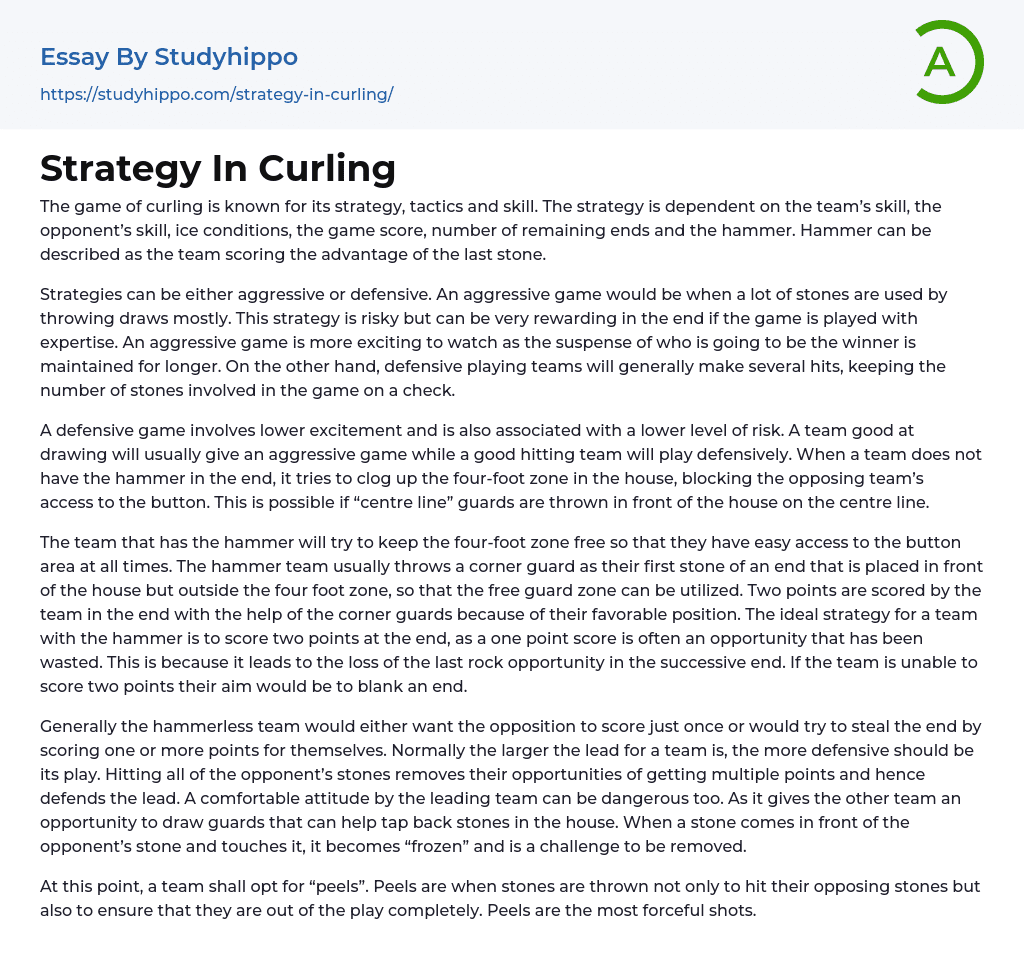Curling is a game that requires strategy, skill, and tactics. The team's skill, the opponent's skill, ice conditions, the game score, number of remaining ends and the hammer are all factors that determine the strategy used. The hammer is the advantage of the last stone held by the scoring team.
There are two types of game strategies: aggressive and defensive. An aggressive strategy involves throwing many draws and using a lot of stones, which is risky but can be very rewarding with skillful playing. Aggressive games are more thrilling to watch as the suspense of the winner is sustained. Conversely, defensive teams make several hits to restrict the number of stones used in the game.
A defensive strategy in the game is less thrilling and involves less risk. A team that
...excels at drawing typically plays aggressively, while a team skilled at hitting tends to play defensively. When a team lacks the hammer during the end, they aim to block the opponent's access to the button by obstructing the four-foot zone in the house. An approach to achieve this is via "centre line" guards on the centre line in front of the house.
When a team has the hammer in curling, they aim to maintain a clear path to the button area by keeping the four-foot zone free. Typically, the hammer team will throw a corner guard outside of this zone as their first stone in an end, allowing them to utilize the free guard zone. This strategic move can help them score two points by the end of the turn, thanks to the advantageous position of the corner guards. Ideally, a team with th
hammer aims to score two points in every end. Scoring only one point means that they have missed an opportunity and risk losing a crucial chance to throw last in the following turn. When unable to score two points, their goal shifts to trying to blank the end.
Typically, the hammerless team aims to either limit the opposition to one score or achieve a steal by scoring one or more points themselves. It is advisable for the leading team to adopt a defensive strategy as the size of their lead increases. Striking all of the opponent’s stones will eliminate their chances of scoring multiple points and thus protect the lead. However, a complacent attitude by the leading team can also be risky. This is because it provides opportunities for the opposing team to draw guards and tap back stones in the house. If a stone comes into contact with an opponent’s stone and stays there, it becomes "frozen" and presents a challenge to remove.
When a team wants to remove opposing stones from play completely, they can choose to use "peels". This involves throwing stones forcefully in order to hit the opposing stones and remove them from play.
- Fight club essays
- Training essays
- Athletic Shoe essays
- Gym essays
- Yoga essays
- Baseball essays
- Basketball essays
- Bodybuilding essays
- Boxing essays
- Football essays
- Golf essays
- Martial Arts essays
- Soccer essays
- Tennis essays
- Volleyball essays
- badminton essays
- cricket essays
- go kart essays
- hockey essays
- scuba diving essays
- snowboarding essays
- wrestling essays
- Surfing essays
- Swimming essays
- Table tennis essays
- Athletes essays
- Running essays
- Ski essays
- American Football essays
- Super Bowl essays
- Taekwondo essays
- Olympic Games essays
- Motorcycle essays
- Benefits of Exercise essays
- Sportsmanship essays
- Virtual Reality essays
- Major League Baseball essays
- Catcher essays
- Jackie Robinson essays
- Kobe Bryant essays
- Anabolic Steroid essays
- The New Yorker essays
- National Football League essays
- Mixed Martial Arts essays
- Competition essays
- Effective Leadership essays
- Leadership Styles essays
- Public relations essays
- Planning essays
- Mission Statement essays




